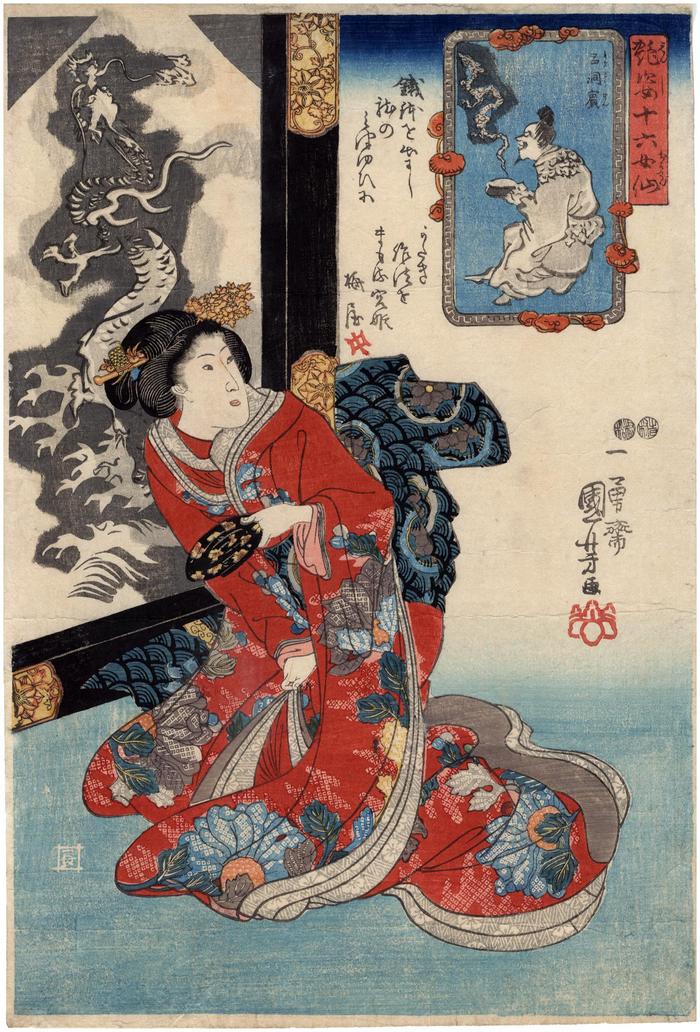Utagawa Kuniyoshi (歌川国芳) (artist 11/15/1797 – 03/05/1861)
Ryo Dōhin (呂洞賓, aka Lu Dongbin) from the series Sixteen Female Sennin Charming Creatures (Enshi juroku josen - 艶姿十六女仙)
1846 – 1848
10 in x 15 in (Overall dimensions) Japanese color woodblock print
Signed: Ichiyūsai Kuniyoshi ga
一勇斎国芳画
Artist's seal: kiri
Publisher: Aritaya Seiemon (Marks 014 - seal 17-011)
Censors' seals: Muramatsu and Yoshimura
British Museum
Nationaal Museum van Wereldculturen (Rijksmuseum Volkenkunde, Leiden) via Ritsumeikan University
Victoria and Albert Museum "Lü Tung-pin (呂洞賓), circa A.D. 750, a scholar and recluse who learnt the secrets of Taoism from Chung-li Ch'üan, the Chief of the Eight Immortals, and attained to immortality at the age of 50. He is the patron saint of the barbers, and is also worshipped by the sick. In his right hand he holds a Taoist fly-brush, and his emblem, a sword, is generally slung across his back. He was exposed to a series of temptations, ten in number, and having overcome them, was invested with a sword of supernatural power, with which he traversed the earth, slaying dragons, and ridding the world of various forms of evil for upwards of 400 years."
Quoted from: Chinese Symbolism and Art Motifs by C.A.S. Williams, pp. 153-4. [Note that the fly-brush and sword are absent from this print. Not only that Lü Tung-pin is conjuring a dragon and not slaying that. And, if you look closely at the frame of the inset image there is, what appears to be, a ju-i fungus - pronounced 'ru-ee', which is something people would wish upon to get what they desired.
One more point: the screen behind the beautiful woman shows a dragon rising from the waves toward the heights of Mt. Fuji or even higher.]
****
Whereas Williams refers to Lü Tung-pin as a dragon slayer there are many representations of this Taoist immortal which are more like those of a dragon-befriender. This is more in keeping with the two portrayals of dragons in this Lyon Collection Kuniyoshi print. In fact, in China by the 13th century many artist were portraying a completely different type of Lü Tung-pin. Ma Yuan, one of the greatest Chinese artists of all time, painted an image of the immortal rising heavenward while standing on the head of a dragon.
In fact, whichever story about Lü Tung-pin you choose is fine. This is not an either/or situation. In Chinese Mythology from A to Z by Jeremy Roberts, p. 76, it relates both sides. "Another story says that when he was still a young student, he met a dragon who gave him a magic sword that would conceal him when he visited Heaven. Another says that, after successfully overcoming 10 temptations, he won a sword that had supernatural powers to fight evil. Others say that Lu Dongbin traveled the world for 400 years, mixing with ordinary people and using his magic sword to slay evil dragons, help the good and conquer ignorance."
Roberts also notes that this immortal is the guardian of ink makers.
****
Struggle with the name of this Taoist figure: not only are there multiple Anglicized spellings of his name in Chinese, but even the Japanese version is a bit confusing. The British Museum calls him 'Ryo Dōhin'. The Museum of Fine Arts in Boston refers to him as 'Ryodohin'. Merrily Baird calls him 'Ryotohin'.
****
About 'sibling pictures'
"'Sibling pictures' (e-kyōdai) are works in which a small inset picture in a cartouche resembles the main part of the design in some way, creating an interesting comparison between the two. This kind of pictorial device was already used in works by Torii Kiyonaga dating from the 1780s, but the name comes from Santō Kyōden's comic novel (kokkei-bon) E-kyōdai (Sibling Pictures), published in 1794."
Quoted from: The Passionate Art of Kitagawa Utamaro, published by the British Museum Press, London, 1995, text volume, p. 181.
****
There is another copy of this print at the Mitake Museum.
****
The poem reads:
竜の
みつゆひに
かたき
作法を
まもる宮姫
梅屋(糸巻)
Aritaya Seiemon (有田屋清右衛門) (publisher)
beautiful woman picture (bijin-ga - 美人画) (genre)
mitate-e (見立て絵) (genre)
